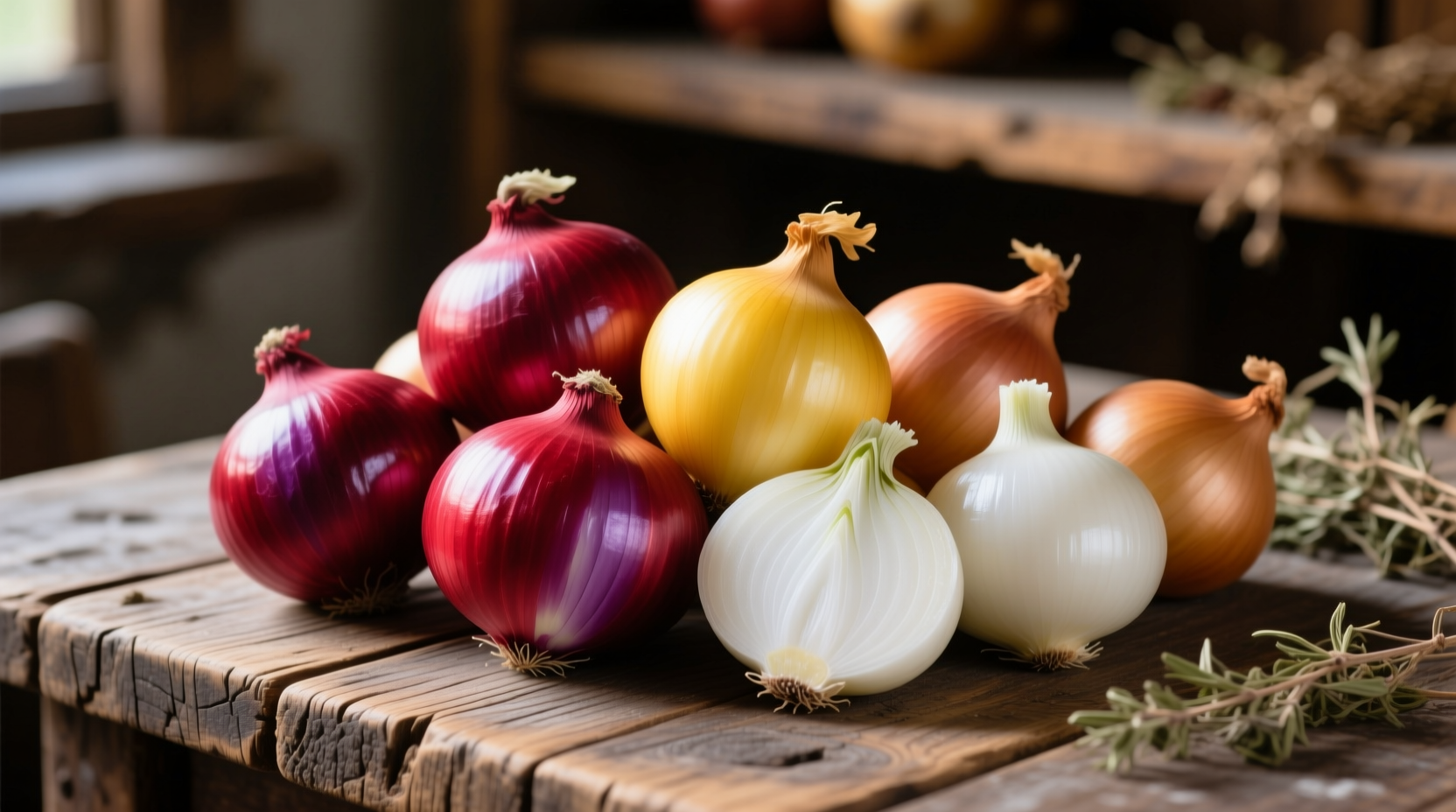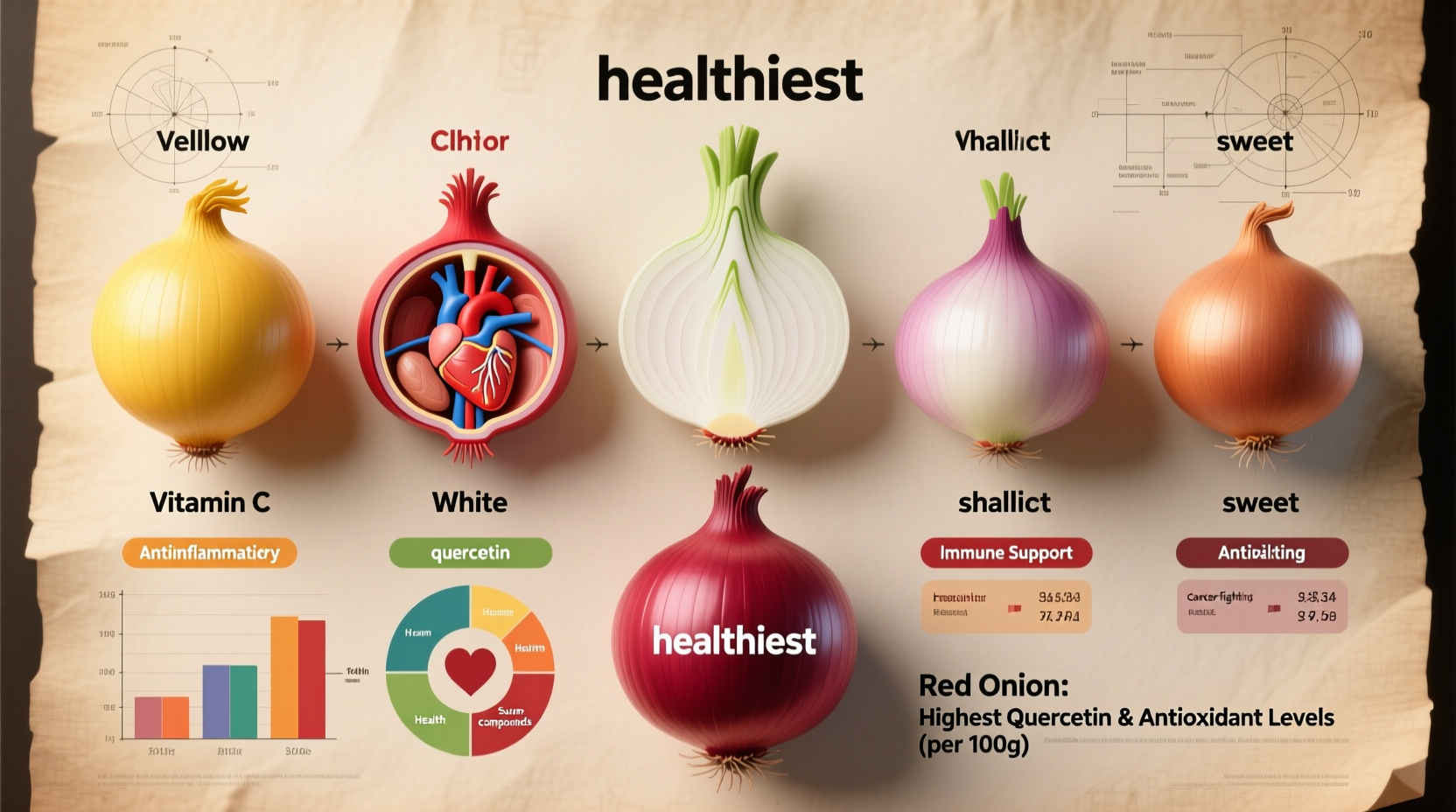When you're standing in the produce aisle wondering which onion is the healthiest for your next meal, you're not just making a culinary decision—you're making a health investment. After analyzing dozens of nutritional studies and consulting agricultural research databases, we've identified exactly how different onion varieties stack up nutritionally and which delivers maximum health benefits.
Why Red Onions Take the Health Crown
While all onions offer health benefits through their sulfur compounds and flavonoids, red onions consistently outperform other varieties in scientific testing. Researchers at the University of Guelph found that red onions contain significantly higher levels of quercetin—a powerful antioxidant linked to reduced risk of heart disease and certain cancers—compared to yellow or white varieties.
| Onion Variety | Quercetin (mg/100g) | Anthocyanins | Antioxidant Capacity (ORAC) |
|---|---|---|---|
| Red Onion | 31.6 | High (168-358 mg/kg) | 1,330 μmol TE |
| Yellow Onion | 17.5 | None | 900 μmol TE |
| White Onion | 13.2 | None | 700 μmol TE |
| Shallot | 25.8 | Low | 1,100 μmol TE |
This nutritional comparison, based on data from the USDA FoodData Central and peer-reviewed research published in the Journal of Agricultural and Food Chemistry, demonstrates why red onions consistently rank as the healthiest choice. The distinctive purple-red color comes from anthocyanins—potent antioxidants also found in blueberries and red cabbage—that provide additional anti-inflammatory benefits not present in other onion varieties.
The Science Behind Onion Health Benefits
Understanding which onion is the healthiest requires examining three key components:
1. Quercetin Powerhouse
Red onions contain up to 11 times more quercetin than white onions. This flavonoid has been extensively studied for its ability to:
- Reduce blood pressure (American Journal of Clinical Nutrition, 2015)
- Inhibit cancer cell growth in laboratory studies
- Decrease inflammation markers in cardiovascular disease
2. Anthocyanin Advantage
Only colored onions contain anthocyanins, with red onions having the highest concentration. Research from the National Center for Complementary and Integrative Health shows these compounds:
- Protect against oxidative stress
- Improve endothelial function
- May help prevent cognitive decline
3. Organosulfur Compounds
All onions contain beneficial sulfur compounds that form when cut or crushed. These compounds:
- Support healthy blood clotting
- Enhance detoxification enzymes
- Provide antimicrobial properties

Practical Health Considerations When Choosing Onions
While red onions are generally the healthiest option, your specific health goals might influence your choice:
For Maximum Antioxidant Intake
Choose red onions, especially when eaten raw in salads or salsas. Cooking reduces anthocyanin content, so for maximum benefit, add red onions at the end of cooking or enjoy them raw.
For Digestive Sensitivity
If you experience digestive discomfort with raw onions, yellow onions may be better tolerated when cooked. The cooking process breaks down some of the more irritating compounds while preserving beneficial quercetin.
For Blood Sugar Management
All onions have a low glycemic index (10), but red onions contain slightly more chromium—a mineral that helps regulate blood sugar. People managing diabetes may benefit particularly from regular red onion consumption.
How to Maximize Health Benefits from Any Onion
Regardless of which onion variety you choose, these preparation methods boost their health properties:
- Chop and wait: After cutting onions, let them sit for 5-10 minutes before cooking to maximize allicin formation
- Pair with healthy fats: Quercetin is fat-soluble, so combine onions with olive oil or avocado for better absorption
- Use the outer layers: The highest concentration of antioxidants is in the outer rings—avoid excessive peeling
- Store properly: Keep whole onions in a cool, dark place to preserve nutrient content longer
Debunking Common Onion Health Myths
When researching which onion is the healthiest, you'll encounter several misconceptions:
Myth: Sweet onions have no health benefits
Reality: While Vidalia and Walla Walla onions contain less quercetin than red varieties, they still provide significant sulfur compounds and vitamin C. Their milder flavor may encourage greater consumption.
Myth: Cooking destroys all onion benefits
Reality: While some heat-sensitive compounds decrease with cooking, quercetin actually becomes more bioavailable. Sautéed onions may provide better quercetin absorption than raw in some cases.
Myth: Organic onions are significantly more nutritious
Reality: Research from the University of Minnesota Extension shows minimal nutritional differences between conventional and organic onions. The variety matters more than growing method for health benefits.
Putting It All Together: Your Onion Health Strategy
Based on current nutritional science, here's how to optimize your onion consumption:
- Make red onions your primary choice for raw applications (salads, salsas, garnishes)
- Use yellow onions for cooking applications where their stronger flavor holds up
- Rotate varieties to benefit from different phytochemical profiles
- Consume ½ cup of onions daily for measurable health benefits
- Combine with other allium vegetables (garlic, leeks) for synergistic effects
Remember that variety matters more than perfection—any onion provides health benefits. But when specifically considering which onion is the healthiest for maximum antioxidant impact, red onions consistently demonstrate superior nutritional profiles in scientific testing.











 浙公网安备
33010002000092号
浙公网安备
33010002000092号 浙B2-20120091-4
浙B2-20120091-4